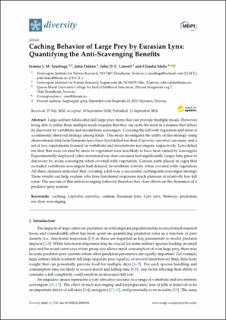Caching Behavior of Large Prey by Eurasian Lynx: Quantifying the Anti-Scavenging Benefits
Peer reviewed, Journal article
Published version
Permanent lenke
https://hdl.handle.net/11250/3027352Utgivelsesdato
2020-09-13Metadata
Vis full innførselSamlinger
- Artikler (Articles) [173]
- Publikasjoner fra Cristin - DMMH [138]
Sammendrag
Large solitary felids often kill large prey items that can provide multiple meals. However, being able to utilize these multiple meals requires that they can cache the meat in a manner that delays its discovery by vertebrate and invertebrate scavengers. Covering the kill with vegetation and snow is a commonly observed strategy among felids. This study investigates the utility of this strategy using observational data from Eurasian lynx (Lynx lynx)-killed roe deer (Capreolus capreolus) carcasses, and a set of two experiments focused on vertebrate and invertebrate scavengers, respectively. Lynx-killed roe deer that were covered by snow or vegetation were less likely to have been visited by scavengers. Experimentally-deployed video-monitored roe deer carcasses had significantly longer time prior to discovery by avian scavengers when covered with vegetation. Carcass parts placed in cages that excluded vertebrate scavengers had delayed invertebrate activity when covered with vegetation. All three datasets indicated that covering a kill was a successful caching/anti-scavenger strategy. These results can help explain why lynx functional responses reach plateaus at relatively low kill rates. The success of this anti-scavenging behavior therefore has clear effects on the dynamics of a predator–prey system.

